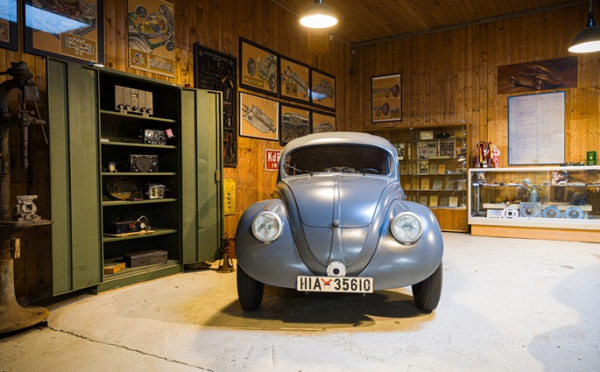World’s oldest surviving VW Beetle is back on the road

Admittedly, there wasn't much left of it when restoration work started but the oldest surviving Volkswagen (VW) Beetle has truly been through an odyssey and even survived the turmoil of World War II, reported dpa.
Traugott Grundmann's Beetle is thought to be the oldest anywhere in the world and it can be found on display at the collector's home in Hessisch Oldendorf.
The owner goes for regular runs in the little car with its 23-horsepower, air-cooled engine mounted at the back and this author joined him for a road trip.
"This is driving in its purest form, back to basics, so to speak," says Grundmann" as we bowl along – "and it's loud."
Germany's TueV testing authority has certified that the car is safe up to a top speed of 100 km/h but Grundmann admits that things get a little bumpy above 80.
It is above all cramped inside. "People used to be smaller," says the enthusiast. This means that anyone taller than 1.80 metres tall will have trouble stretching their legs under the steering wheel. Grundmann can still manage it although he has to hunch over in order to see out of the windscreen.
The car was built in 1937 as the Volkswagen W30 – still at the former Porsche engineering office and with support from Mercedes. After the three so-called V models, which no longer exist, it was the first prototype series for what would later become the VW Beetle.
"These 30 test cars were built on behalf of Ferdinand Porsche for a large-scale road test and are considered the direct precursors of the later VW Beetle," says an expert from the TueV Nord.
The Beetle was a pet project of Nazi dictator Adolf Hitler who promised Germans an affordable "people's car". The W30 was, so to speak, the dress rehearsal for the later VW Beetle.
During World War II, the prototypes were scrapped, as can be seen in the pictures that Grundmann has hung in his exhibition. "They just needed the materials." The chassis with the number 26 had travelled a good 56,000 kilometres by then.
According to the TÜV, which confirmed the authenticity of the 26, there is no evidence of any other remaining frames or bodies. This means that the now rebuilt car is the world's oldest VW Beetle.
By the early 1970s at the latest, chassis number 26 had turned up in Gmünd in Carinthia, Austria, mounted under another vehicle – a so-called Kübelwagen, a type of open, military Beetle.
After passing through the hands of various collectors, the frame ended up with a classic car enthusiast in Austria. In 2003 Grundmann swapped it for a Schwimmwagen – a type of amphibious VW Beetle
In Hessisch Oldendorf, the chassis was initially "just propped up against the wall," said Grundmann. He didn't really believe he could rebuild it. However, the restoration of a VW Beetle from 1938, which was in much better condition, gave him the courage to proceed. First, the entire chassis was rebuilt, and then one thing led to another.
Today, the W30 stands alongside the 1938 Beetle in a specially prepared room in Grundmann's collection, which includes numerous other VW models and a 1950s bar. A book has also been written about the W30's restoration, which can be found in the wood-panelled garage along with numerous pictures and original documents.
The master roofer and former Air Force flight instructor spent almost eight years working on the historic vehicle. "With a Beetle, you can still do almost everything yourself," he says.
The bodywork was completely rebuilt by a specialist company. The basis for this was a life-size drawing of the vehicle by Andreas Mindt, then Audi and now VW chief designer, which he created using photos and the chassis. "A proper construction drawing was no longer available," says Grundmann.
Mindt says working on the car was more than just a challenge for him as an engineer, it was also an opportunity to immerse himself in a period when Volkswagen was defining itself. "For me, this car is not just a prototype – it is a link between craftsmanship, heritage and the future of Volkswagen design."
Grundmann says that many people helped with the reconstruction which included a worldwide search for components. Parts turned up in Britain, France and Poland. At the time many of the items were not manufactured exclusively by VW for the prototype and were proprietary bought-in products.
When registering the car, the main focus was on ensuring that it was roadworthy. Exemptions were found for some modern regulations. For example, instead of a permanently-installed hazard warning light, the car only has a mobile system. Ultimately, the road traffic authority approved the W30 without any objections.
Grundmann does not cover long distances in the cramped, drab grey-painted vehicle and he also avoids driving in the rain so as not to encourage rust. A VW Beetle or classic car meet is however a must and Grundmann squeezes himself into the car, leans forward, and off he rolls.
- World
- Oldest
- Surviving
- Volkswagen
Source: www.dailyfinland.fi
